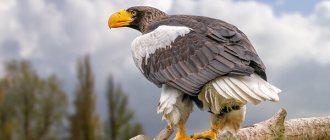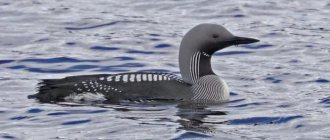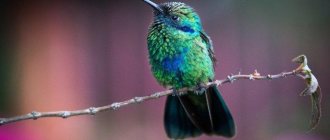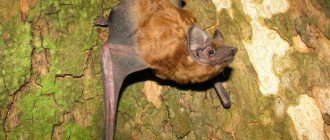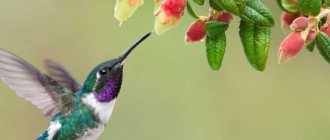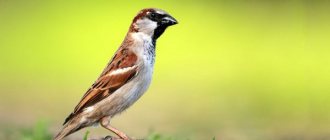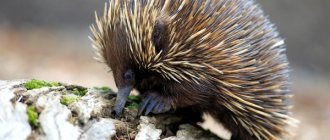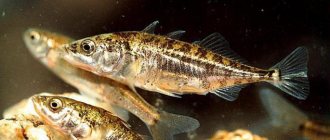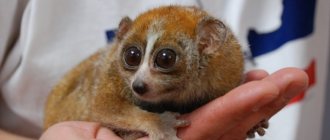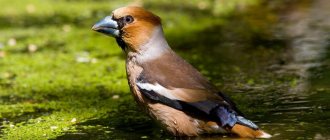| Latin name: | Buteo rufinus |
| English name: | To be confirmed |
| Kingdom: | Animals |
| Type: | Chordata |
| Class: | Birds |
| Squad: | Accipitridae |
| Family: | Accipitridae |
| Genus: | Real buzzards |
| Body length: | 57-65 cm |
| Wing length: | To be confirmed |
| Wingspan: | 135—160 cm |
| Weight: | 600—1800 g |
Description of the bird
The body length of the Buzzard is from 57 to 65 cm, the wingspan is from 135 to 160 cm, and the weight is from 600 to 1800 g. The female is usually larger than the male. The length and shape of the wings of the bird resembles an eagle. She also has a long tail and legs.
— Advertising —
The Buzzard is characterized by the presence of individuals with different predominant shades in the plumage, the so-called light and dark varieties.
The plumage of the light-colored Buzzard is mainly reddish-buff, the head is lighter colored than the back and chest, and the belly and sides, on the contrary, are darker. The tail is light with a reddish tint, without transverse stripes. On the underside of the wings, a wide white spot is clearly visible, which is formed by the webs of the flight feathers.
There are also dark-colored birds with blackish-brown plumage, light-colored flight feathers below and with a dark border, and a light tail decorated with transverse stripes. In flight, the Buzzard of this color is very similar to the dark-colored buzzard and rough-legged buzzard, but differs from them in body proportions and the absence of a light crescent spot in the chest area.
Young individuals have lighter plumage than adults, they have no rufous markings, their bellies are light, there are small stripes on their tails, they do not have dark spots on the folds of their wings or a border along the edge. On the top of the wings of the young animals there are noticeable light spots, similar to the color of a young rough-legged buzzard.
— Advertising —
The iris is whitish in young birds, brown in adults.
Appearance
A very massive predator that can reach impressive sizes. It is considered the largest flying mammal in the entire Palearctic. The length of the body can reach more than seventy centimeters, and the wingspan is amazing and varies from 150 to 180 centimeters, which already exceeds the average height of an ordinary person. In many ways it is similar to its brother, the buzzard, but the size of the buzzard is more significant, and its wings have a larger mass. With such a large build, the weight of the bird, with rare exceptions, exceeds 2-3 kilograms, which is why the animal seems too skinny, but this does not affect its life in any way.
This is a long-legged, long-tailed and long-winged bird, which, despite all this, has a rather small head. On her lower legs there are noticeable folds of skin, forming something similar to human pants. The tail is long and sharp, and because of the cut in the center, one gets the feeling that it is part of the wings.
It does not have any variegated coloring, but it is problematic to call this bird invisible. The body has several shades of reddish or ocher color, the head is lighter, and the belly and some parts of the sides are noticeably darker than the rest of the limbs. The tail is painted a monotonous red color without stripes or spots. When the Buzzard takes off, on the inside of its wing you can see a rather wide spot of white color, which is formed due to the flight feathers. If you approach almost end-to-end, which is not possible for an ordinary tourist, you will notice small stripes on the back. In rare cases, a given bird has a different color from the usual one, for example, the plumage is unnaturally dark, some areas are covered with spots, or other differences. All this happens due to deviations in the genetic code that do occur, but this is only an exception to the rule. During flight, the Buzzard with dark feathers is practically indistinguishable from individuals of the Buzzard or even the Buzzard, which can also have dark shades instead of light ones. In addition to its size, this mammal differs from its fellows in the absence of transverse lightening on the chest.
Young individuals are smaller and lighter than older individuals, but even so, they do not show any significant differences with age.
Features of the Buzzard's diet
The Buzzard's diet mainly consists of small mammals. So, among its typical prey are voles, hamsters, pikas, gophers, long-eared hedgehogs, and little hares.
In addition, the Buzzard preys on reptiles, amphibians, and large insects, such as locusts.
In winter, when such live prey becomes insufficient for adequate nutrition, the Buzzard may include carrion in its diet.
The Buzzard hunts in the air, catches prey directly from its soaring flight, and occasionally can even pursue it on the ground.
Peculiarities
In flight
The Buzzard measures from 57 to 65 cm and has a wingspan of 135 to 160 cm, making it the largest buzzard of the western Palearctic. The length and shape of the wings of the Buzzard makes it look like an eagle. The Buzzard can also be easily confused with the Common Buzzard subspecies Buteo buteo vulpinus, however it is larger and has wider wings. The Buzzard is also similar to the Buzzard, but the latter never has reddish tones in its plumage.
Buzzards have polymorphism in appearance. Latin name rufinus
, which translates to reddish or rufous, comes from phenotypes with light or reddish plumage. Their head and chest are light in color without any inclusions and contrast with the reddish belly and paws. Young Buzzards also have a light head and chest, and the underparts are off-white with a striped tail. The light feathers of the wings are also without inclusions, but are dark at the ends. In addition to the reddish phenotype, there is a light and dark phenotype, as well as numerous transitional forms. Different phenotypes can occur within the same subspecies.
The sounds made by the buzzard are similar to those of the common buzzard, but are longer, although in general the buzzard is quieter. The cubs call their parents to give them food with the sounds of “peck-peck”.
Bird distribution
The habitat of the Buzzard is quite wide, and includes North Africa, Greece, Turkey, forest-steppe, steppe and desert regions of Eurasia, starting from the Black Sea region and up to the Caucasus, western Mongolia, India, and the Arabian Peninsula.
Buzzards living in temperate regions migrate south for the winter to the semi-deserts of sub-Saharan Africa or to the northern regions of India. Birds return from their wintering grounds in early spring. Some populations lead a sedentary lifestyle.
The habitats for the Buzzard are both mountainous and open landscapes, including steppes and semi-deserts. Even in real deserts, provided there is a sufficient amount of food in them, the Buzzard can organize its life. In the Balkans, birds often nest in forested mountain ranges at medium altitudes. That is, both open spaces for hunting and secluded places for nesting are important for the habitat of the Buzzard. In general, buzzards are found at altitudes up to 2700 m above sea level.
The Buzzard usually chooses open, dry spaces to live in, where it can easily find food. The bird nests on rocks, ledges of ravines, as well as pillars and towers, occasionally in trees, and sometimes even on flat ground.
The total population size of the long-legged buzzard varies greatly in different years, but in the European zone of Russia, for example, it is gradually decreasing. Therefore, the species is included in the Red Book of Russia.
Lifestyle and behavior
The Buzzard is one of the most important inhabitants of the dry space of its habitat. His lifestyle is associated with constant hunting and flying in different directions. This far from small bird prefers to nest on high branches. Construction of a nest takes a long time, and the place of residence itself is of impressive size to accommodate not only one individual, but also eggs, as well as a partner. The main places of residence are various ravines, rocks, pillars or towers. Sometimes, due to the lack of a better and more suitable place, an animal has to build its nest among many tree branches, and in extreme cases, it settles on ordinary flat ground, but does not live there for a long time and tries to quickly find a better place to stay.
In addition to the vastness of the territory, Buzzards look for high places for good visibility, thanks to which they will be able to quickly find prey and attack it with great speed. Even the nests of ravens act as dwellings, with which the hawk bird comes into conflict and literally takes away their abode.
Common Buzzard Species
Long-legged Buzzard (Buteo hemilasius)
The body length of the bird is from 57 to 67 cm, the wingspan is 143-161 cm. Males are smaller in size than females by about 20%. The plumage of this species includes, as for the common buzzard, light and dark morphs, which differ from each other by the presence of more or less red-brown feathers. The legs of the long-legged buzzard are partially feathered and in places covered with scales.
This species lives in open steppes, deserts and mountains, at altitudes from 1,000 to 4,500 m. In winter, the bird can also be found at sea level.
The main nesting area begins in the eastern regions of the Tien Shan and extends to Altai, eastern and western Manchuria, the southern regions of Tibet and the Himalayas. In winter, birds migrate to the south, for example, to Korea, northern and central China, northern India, Turkestan, and some individuals fly to Japan and southeast Iran.
Links
Other books on request "Buzzard" >>
Buzzard
Irina Gruzdilovich, Miory district (Vitebsk region)
Places of registration since 2000:
Brest region – Brest, Kamenets, Luninets districts
Vitebsk region – Postavy district
Gomel region – Khoiniki district
Accipitridae family – Accipitridae
A very rare accidental migrant. It was first registered on the territory of Belarus on August 1, 1996, when one individual was caught in the Kamenets district of the Brest region. Subsequently, it was recorded several more times in the south of the country and once in the north. On April 12, 2006, an adult was registered in Belovezhskaya Pushcha in the vicinity. Chernaki village, Kamenets district; 09/19/2009 1 individual near the village of Bernada, Brest district; 09/05/2015 1 individual at the Novinki fish farm, Postavy district; 08/15/2016 a young individual in the vicinity. Lakhva village, Luninetsky district; 06/07/2017 1 individual in the vicinity. Strelichevo village, Khoiniki district.
Finally, the last observation occurred on September 25, 2019 in the Miory district.
Irina Gruzdilovich, Miory district (Vitebsk region)
Outwardly similar to the common buzzard, but larger. The color of the plumage is not so variable, although both lighter and darker colored birds are found. Distinctive features are also the faint striping of the tail feathers (from a distance the tail appears to be one color) and clearly visible dark brown spots on the bend of the wing on the underside. Bird weight (both sexes) 600-1800 g, body length 55-65 cm, wingspan 126-155 cm.
- Birds of Prey: photos with names and descriptions
Inhabitant of steppe and desert landscapes. It feeds on gophers and mouse-like rodents, and less often catches birds and reptiles.
It nests in the steppes and semi-deserts of Eastern Europe and Asia; in some places the nesting range extends into the forest-steppe zone. In particular, nesting of this species has recently been established in the north of Ukraine, not far from the borders with Belarus.
Literature
1. Grichik V.V., Burko L.D. “Animal world of Belarus. Vertebrates: textbook. manual” Minsk, 2013. -399 p.
2. Nikiforov M. E., Samusenko I. E. “Finds and encounters of birds, approved by the Belarusian Ornitho-Faunistic Commission on December 16, 2009.” / Subbuteo No. 10, 2011. P.70-77
3. Nikiforov M. E., Samusenko I. E. “Finds and sightings of birds, approved by the Belarusian Ornitho-Faunistic Commission on February 14, 2008.” / Subbuteo No. 10, 2011. P.62-69
4. Minutes of the meeting of the BOFK No. 3 (2018) dated 04/03/2018.
5. Gruzdzilovich Irina and Gruzdzilovich Vyacheslav “Personal observation with photographic material from 09.25.2019” / birdwatch.by
| Buzzard | |
| Scientific classification | |
| intermediate ranks Domain: | Eukaryotes |
| Kingdom: | Animals |
| Sub-kingdom: | Eumetazoans |
| Without rank: | Bilaterally symmetrical |
| Without rank: | Deuterostomes |
| Type: | Chordata |
| Subtype: | Vertebrates |
| Infratype: | Ghostostomes |
| Superclass: | Quadrupeds |
| Treasure: | Amniotes |
| Class: | Birds |
| Subclass: | fantail birds |
| Infraclass: | New palates |
| Treasure: | Neoaves |
| Squad: | Accipitridae |
| Family: | Accipitridae |
| Subfamily: | Buzzards |
| Genus: | Real buzzards |
| View: | Buzzard |
(Cretzschmar, 1827) Range Breeding only Occurs all year round Occurs during migration
Winters
Conservation statusLeast ConcernIUCN 3.1 Least Concern: 22736562
| ITIS | 175392 |
| NCBI | 115134 |
| FW | 94491 |
Buteo rufinus cirtensis
egg – Toulouse Museum
Kurgannik
[1] (lat. Buteo rufinus) is a bird of prey from the genus of true buzzards of the hawk family (
Accipitridae
).
Reproduction of the Buzzard
The nests of the Buzzard are very massive - up to a meter or more in diameter and height. The main building material for nests is branches. Since birds can use the same nest for several years, it becomes larger and larger over time. Inside the nest, long-legged buzzards make bedding from cereals, dry manure, wool, and rags.
The bird's nest is usually built in elevated places from which the surrounding area is clearly visible. On the Balkan Peninsula, ledges of steep cliffs are often used for these purposes; in other regions, birds can also build them on trees. In areas where there are few suitable trees, nests of buzzards are found directly on the ground, and sometimes even on power poles.
In the first half of April, egg laying occurs. In one clutch, the female has from 2 to 5 eggs, dirty white in color, with brown spots of varying intensity. The incubation period for the eggs lasts up to 35 days, after which the chicks are born around May or early June, and the parents feed them in the nest for about 6 weeks. Both parents always take care of the chicks. The first downy plumage of Buzzard chicks is ocher-grayish in color, the second is light gray. In June, the Buzzard chicks begin to fly.
After the nesting period, Buzzards migrate from arid areas to the forest-steppe; birds fly south in early autumn.
Buzzard
Kingdom: animals (Animalia). Phylum: chordates (Chordata). Class: birds (Aves). Order: Falconiformes. Family: Accipitridae (Accipitridae). Genus: true buzzards (Buteo). Species: Buzzard (Buteo rufi nus).
Where does he live?
The northernmost part of the world's Buzzard population lives in southwestern Russia. However, it is worth noting that the species is distributed very unevenly throughout the territory. Nesting sites are separated from each other by tens and hundreds of kilometers. Buzzards prefer to settle in steppe, semi-desert and desert areas with sparse vegetation. However, they can also be found in mountainous areas, at an altitude of 2700 m above sea level, where there are also places suitable for nesting of these representatives of the hawk family.
The Buzzard builds its nests very high (up to 20 m), on lonely trees or rocks, and sometimes on power line supports. All it needs is a suitable place to nest and hunt. But sometimes the bird doesn’t find it either. Buzzards prefer to winter in warm countries: Africa, India, the Near and Middle East.
External signs
The Buzzard is a very large, impressive bird, and it is not without reason that it is rightfully considered the largest buzzard in the Palearctic. Its body length can reach 65 cm, and its wingspan can reach 160 cm. This bird can easily be confused with a common buzzard. However, unlike the buzzard, the buzzard boasts more massive wings, and it itself is somewhat larger. Interestingly, Buzzards are characterized by color polymorphism.
The Latin name of the species, rufi nus, means “reddish.” The Buzzard received this name due to those individuals whose plumage color is dominated by reddish and reddish shades. But there are also gray or brown birds. The coloration of Buzzards is quite variable, even within the same family. Most often, the head and chest of these birds are painted in light colors.
Lifestyle
Like all predators, the Buzzard is constantly on the alert. Therefore, he prefers to build his nest on high ground, from where it is convenient to observe everything that is happening. A tall tree, a steep ledge and rocks, a support for power lines - all this can be suitable for a Buzzard as a place to build a nest. The main thing is that the review is good. If there is an abandoned raven nest nearby, it may become a suitable home for the Buzzard. Why waste energy on a new building?! In the first half of April, the female lays from two to five eggs and begins incubation. After birth, the chicks do not leave their parent’s nest for about two months, gaining strength and life experience.
Buzzards feed on small rodents: ground squirrels and gerbils. They will happily feast on insects, such as locusts, as well as reptiles, including lizards. And in winter they will not refuse carrion.
In the Red Book of Russia
The Buzzard is listed in the Red Book of Russia as a rare and endangered species. Its numbers have declined sharply in the last century, largely due to intensive human agricultural activity. The plowing of fields has led to the disappearance of places suitable for hunting and nesting of these majestic birds.
This is interesting
All buzzard chicks are born defenseless and helpless. “Klui-klui” comes from the nest. Parents know that the chicks are asking for food, and they rather rush to satisfy their appetite. The male and female get food for the babies and at first even tear it into pieces for their young. The very first thing buzzard chicks must learn is to tear apart prey on their own. Then the parents bring live prey to the nest, leave it, and fly away themselves. How else can chicks learn to hunt on their own?! This is how, gradually, developing predatory skills, adults prepare their offspring for independent life.
It happens that the chicks of birds of prey, leaving the nest, do not yet fly confidently. They sit for a long time in one place, on some branch, and watch what is happening.
Similar types:
Osprey Harpy PhilippineGolden Eagle
Voice of the Buzzard
Usually the Buzzard is a very silent bird. The sounds that the buzzard can make are reminiscent of the call of the common buzzard, but they differ in duration, volume and lower sound. When restless, the bird calls out short “kee-kee” sounds, which resemble a squeal.
The chicks call their parents and ask for food using the sounds “klui-klui-klui”.
Vocal differences also help distinguish the Buzzard from the Buzzard, and prevent these species from being confused during flight. Buzzards are noisy birds; in flight they constantly make melancholy, drawn-out sounds “kayayay-ya, kyyayay”, but buzzards make their flights mostly in silence.
Peculiarities
The Buzzard measures between 57 and 65 cm and has a wingspan of 135 to 160 cm, making it the largest buzzard in the western Palearctic. The length and shape of the wings of the Buzzard makes it look like an eagle. Buzzards can also be easily confused with the common buzzard of the subspecies Buteo buteo vulpinus
, however, is larger and has wider wings. There is also a possibility of confusion with the rough-legged buzzard, but it never has reddish tones in its plumage.
Buzzards have polymorphism in appearance. Latin name rufinus
, which translates to reddish or rufous, comes from phenotypes with light or reddish plumage. Their head and chest are light in color without any inclusions and contrast with the reddish belly and paws. Young Buzzards also have a light head and chest, and the underparts are off-white with a striped tail. The light feathers of the wings are also without inclusions, but are dark at the ends. In addition to the reddish phenotype, there is a light and dark phenotype, as well as numerous transitional forms. Different phenotypes can occur within the same subspecies.
The sounds made by the buzzard are similar to those of the common buzzard, but are longer, although in general the buzzard is quieter. The cubs call their parents to give them food with the sounds of “peck-peck”.
Interesting facts about the bird
In the 50-60s of the twentieth century, a general hunt was announced for all large birds of prey. Many birds, including eagles, buzzards, sea eagles and other species that resemble them in appearance, were declared pests of the hunting industry, which is why a decision was made to exterminate them everywhere. Among other things, people began to destroy the Buzzards. However, a little later, all eagle birds were “rehabilitated” and since then the numbers of these species have been gradually restored.
